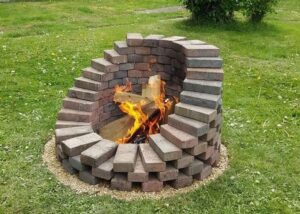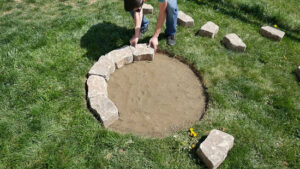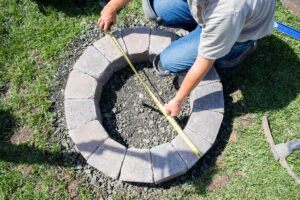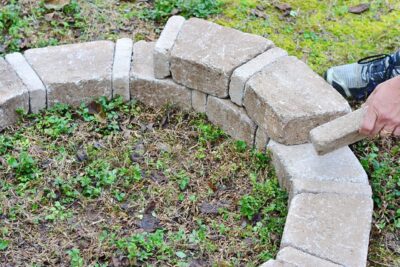Are you ready to add some warmth and ambiance to your backyard? Building a fire pit on grass is a fun and easy DIY project that can be completed in a single afternoon. Not only will a fire pit provide a cozy gathering place for friends and family, but it will also add value to your home. In this guide, we’ll show you step-by-step how to build a fire pit on grass, from selecting the perfect location to choosing the right materials.
Building a fire pit on grass can be a fun and practical outdoor project. There are a few key steps to follow when building a fire pit on grass, including selecting a suitable location, obtaining necessary permits, and properly preparing the ground.
It is important to also follow safety guidelines and consider any local regulations or ordinances when building a fire pit. With careful planning and execution, you can successfully build a fire pit on grass and enjoy the warmth and ambiance of a backyard fire for years to come.
How do you build a fire pit on grass without damaging the lawn?

To build a fire pit on grass, you will need the following:
- A fire pit kit or materials to create a DIY fire pit, such as bricks, pavers, or rocks
- A shovel
- A level
- Landscaping fabric
- Sand or gravel
Here’s a step-by-step guide on how to build a fire pit on grass:
- Choose a location for your fire pit. It should be at least 10 feet away from any structures or trees and be in a level area.
- Mark the circumference of the fire pit using spray paint or flags. The diameter should be at least 3 feet, but it can be larger if you have the space.
- Dig out the grass and soil within the marked area, creating a pit that is about 6 inches deep.
- Lay a layer of landscaping fabric over the bottom of the pit. This will help prevent weeds from growing up through the sand or gravel.
- Fill the pit with a layer of sand or gravel, using a level to ensure it is evenly distributed.
- Place the fire pit kit or materials on top of the sand or gravel, following the manufacturer’s instructions or your own design. Make sure to leave at least a few inches between the top of the pit and the rim for ventilation.
- Add additional sand or gravel around the outside of the fire pit to help with drainage and to create a finished look.
- Test your fire pit by lighting a small fire and making sure it stays contained within the pit.
With a little bit of effort and the right materials, you can easily build a fire pit on grass and enjoy the warmth and ambiance it provides for years to come.
Can you build a fire pit on grass without a concrete base?
Yes, it is possible to build a fire pit on grass without a concrete base, but it is not recommended. A fire pit on grass without a concrete base is more likely to be unstable and could potentially be a safety hazard. It is also more likely to damage the grass, especially if the fire pit is used frequently.
If you still want to build a fire pit on grass without a concrete base, here are a few options you can consider:
1. Build the fire pit on a bed of sand: This can help to stabilize the fire pit and prevent it from sinking into the ground.
2. Use pavers or bricks to create a base: This can help to keep the fire pit off the grass and provide a stable foundation.
3. Build a portable fire pit: There are many portable fire pits available that can be placed on grass without a permanent foundation.
Regardless of which option you choose, it is important to follow all local regulations and guidelines for building a fire pit and to use caution when using the fire pit to prevent accidents or damage.
What are the best materials to use for building a fire pit on grass?
The best materials to use for building a fire pit on grass will depend on the size and design of the fire pit you have in mind, as well as your budget and the tools and materials you have available.
Some options to consider include the following:
1. Brick: Brick is a durable and long-lasting material that can be used to build a fire pit on grass. It is a good choice if you want a more permanent structure, but it can be expensive and may require specialized tools and skills to install.
2. Concrete: Concrete is another durable option for building a fire pit on grass. It is relatively inexpensive and easy to work with, but it can be heavy and difficult to move once it has been poured.
3. Stone: Natural stone can be used to create a rustic, natural-looking fire pit on grass. It is a durable material that can withstand high temperatures, but it can be expensive and may require specialized tools and skills to install.
4. Metal: Metal fire pits are available in a variety of shapes and sizes, and they can be placed on grass without a concrete base. They are typically lightweight and portable, but they may not be as durable as other materials.
No matter which material you choose, it is important to follow all local regulations and guidelines for building a fire pit and to use caution when using the fire pit to prevent accidents or damage.
How do you ensure safety when building a fire pit on grass?
Here are a few tips for ensuring safety when building a fire pit on grass:
Follow all local regulations and guidelines: Different areas have different regulations for building and using fire pits, so it is important to check with your local authorities to make sure you are complying with all relevant laws and regulations.
1. Choose a safe location: Make sure you choose a location for your fire pit that is at least 10 feet away from any buildings, trees, or other structures that could catch fire.
2. Use a fire-resistant material: Choose a material for your fire pit that is resistant to heat and flame, such as brick, concrete, or stone. Avoid using materials that could easily catch fire, such as wood or dry leaves.
3. Build a fire pit that is the right size: A fire pit that is too small may be difficult to control, while a fire pit that is too large may be dangerous. Choose a size that is appropriate for your needs and the size of your yard.
4. Keep a bucket of water or a garden hose nearby: In case of an accidental fire, it is important to have a way to extinguish it quickly. Keep a bucket of water or a garden hose nearby so you can put out the fire if needed.
5. Never leave the fire unattended: Always supervise the fire pit when it is in use, and never leave it unattended. Make sure the fire is completely extinguished before you leave.
Can you use a pre-made fire pit kit on grass?

Yes, it is possible to use a pre-made fire pit kit on grass. Many pre-made fire pit kits are designed to be placed directly on the ground and do not require a concrete base. However, it is important to keep in mind that using a fire pit on grass without a concrete base may not be as stable or safe as using a fire pit with a concrete base.
If you want to use a pre-made fire pit kit on grass, there are a few steps you can take to ensure safety and stability:
1. Choose a flat, level area of grass: A flat, level surface will help to ensure that the fire pit is stable and does not tip over.
2. Use a fire-resistant material to create a base: You can use a fire-resistant material, such as sand or gravel, to create a base for the fire pit. This can help to stabilize the fire pit and prevent it from sinking into the ground.
3. Follow the manufacturer’s instructions: Make sure to follow all of the manufacturer’s instructions when setting up the fire pit. This will help to ensure that the fire pit is properly assembled and safe to use.
Regardless of whether you use a pre-made fire pit kit or build your own fire pit, it is important to follow all local regulations and guidelines for building and using a fire pit and to use caution when using the fire pit to prevent accidents or damage.
How do you properly maintain and care for a fire pit on grass?
Here are some steps you can follow to properly maintain and care for a fire pit on grass:
1. Choose a safe location: Make sure to place the fire pit on a flat, stable surface away from flammable materials such as trees, bushes, and overhanging branches. Keep a safe distance from structures and make sure the fire pit is not located near a gas line or underground utilities.
2. Use a fire pit ring or pad: A fire pit ring or pad can help protect the grass from the heat of the fire and prevent the fire pit from sinking into the ground. You can also use a metal grate or a layer of sand to help distribute the heat evenly and protect the grass.
3. Keep the fire small: A small, controlled fire is less likely to cause damage to the grass and is easier to manage. Avoid using accelerants such as gasoline or lighter fluid, as these can increase the risk of a fire spreading.
4. Extinguish the fire properly: Always use water to extinguish the fire, and make sure the fire is completely out before leaving the area. Pour water on the embers and stir the ashes to ensure that the fire is completely extinguished.
5. Maintain the area around the fire pit: Keep the area around the fire pit clear of debris and leaves, as these can easily catch fire. Trim any grass or plants that are near the fire pit to reduce the risk of fire spreading.
6. Follow local laws and regulations: Check with your local authorities to make sure it is legal to have a fire pit on your property and follow any guidelines or restrictions that may be in place.
What are the best plants and landscaping ideas for around a fire pit on grass?
A fire pit can be a great addition to any backyard, providing a cozy gathering place for family and friends to relax and enjoy the outdoors. When choosing plants and landscaping for around a fire pit on grass, it’s important to consider the safety, aesthetics, and maintenance of the plants.
Some good options for plants around a fire pit on grass might include low-growing ground covers, shrubs with non-combustible foliage, and ornamental grasses.
Here are some plants and landscaping ideas to consider when designing the area around a fire pit on grass:
1. Use fire-resistant plants: Choose plants that are less likely to catch fire, such as succulents, cacti, and other drought-tolerant plants. You can also consider using plants that are resistant to heat and smoke, such as agave, yucca, and aloe vera.
2. Create a seating area: Consider adding a seating area around the fire pit, using comfortable outdoor furniture such as chairs, sofas, and cushions. You can also use potted plants or planters to add color and interest to the space.
3. Add lighting: Soft lighting can help create a cozy and inviting atmosphere around the fire pit. You can use solar-powered lights, lanterns, or string lights to illuminate the area.
4. Use decorative elements: Add decorative elements such as throw pillows, rugs, and cushions to create a warm and welcoming atmosphere. You can also use plants and flowers to add color and interest to the space.
5. Consider the view: If you have a beautiful view from the fire pit area, make sure to incorporate it into the design. Use plants and landscaping elements to frame the view and create a cohesive look.
6. Use materials that complement the surroundings: Choose materials such as wood, stone, and gravel that complement the natural surroundings and add to the overall look and feel of the space.
7. Make it low maintenance: Consider using drought-tolerant plants and hardy materials that require minimal maintenance to keep the area around the fire pit looking its best.
How do you properly extinguish a fire in a pit on grass?
Properly extinguishing a fire in a pit on grass is important for safety and to prevent the spread of fire. Here are some steps to follow when extinguishing a fire in a pit of grass:
1. Allow the fire to burn down: Before you begin extinguishing the fire, allow it to burn down until it is a bed of embers. This will make it easier to extinguish and will also help to prevent any sparks from flying out of the pit.
2. Pour water over the embers: Slowly and carefully pour water over the embers, making sure to cover all areas of the fire. Be sure to use enough water to completely extinguish the fire.
3. Stir the embers: After pouring water over the embers, use a shovel or other tool to stir the embers to ensure that all of the fire has been extinguished.
4. Check for hot spots: Once the fire is extinguished, use the back of your hand to feel for any hot spots that may still be burning. If you find any, pour more water over those areas to extinguish them.
5. Dispose of ash and debris: Once the fire is completely extinguished and all hot spots have been taken care of, dispose of any ash or debris that may be left in the pit. This will help to prevent any stray embers from reigniting the fire.
It’s important to always use caution when extinguishing a fire in a pit on grass, as grass can easily catch fire. Make sure to keep a bucket of water or a hose nearby in case of any emergencies.
Are there any local building codes or regulations to consider when building a fire pit on grass?

There are often local building codes and regulations that apply to the construction of a fire pit on grass. These codes and regulations are typically designed to ensure the safety and proper functioning of the fire pit.
Some of the things that you may need to consider when building a fire pit on grass include the following:
1. Distance from structures: Many building codes specify a minimum distance that the fire pit must be from structures such as houses, sheds, and fences. This is to prevent the fire from spreading to these structures in the event of an accident.
2. Size and location: Building codes may specify the maximum size of the fire pit and the location where it can be built. For example, the fire pit may need to be a certain distance from property lines, or it may need to be located in a specific area of the yard.
3. Materials: Building codes may specify the types of materials that can be used to construct the fire pit. For example, the pit may need to be built with non-combustible materials such as brick or concrete, or it may need to have a screen or other protective barrier to prevent sparks from escaping.
4. Permits: Depending on your location, you may need to obtain a building permit in order to construct a fire pit on grass. This permit is typically issued by the local building department and is required to ensure that the fire pit meets all applicable building codes and regulations.
It’s important to check with your local building department to find out what codes and regulations apply to the construction of a fire pit on the grass in your area. This will help to ensure that your fire pit is safe and compliant with the law.
Recommended:
Can you build a permanent or semi-permanent fire pit on grass?
Yes, it is possible to build a permanent or semi-permanent fire pit on grass. However, there are a few things to consider when building a fire pit on the grass to ensure that it is safe and stable.
1. Permanent fire pits: A permanent fire pit is one that is built to be a permanent fixture in the yard. These pits are typically made of materials like brick or stone and are designed to be long-lasting and durable.
When building a permanent fire pit on grass, it’s important to make sure that the pit is properly anchored to the ground and that it is built to the correct dimensions and specifications.
2. Semi-permanent fire pits: A semi-permanent fire pit is one that can be easily moved or disassembled. These pits are typically made of materials like metal or concrete and are designed to be easily taken apart and reassembled.
When building a semi-permanent fire pit on grass, it’s important to make sure that the pit is properly anchored to the ground and that it is built to the correct dimensions and specifications.
Regardless of whether you are building a permanent or semi-permanent fire pit on grass, it’s important to follow all local building codes and regulations and to use caution when using the fire pit. Make sure to keep a bucket of water or a hose nearby in case of any emergencies, and always extinguish the fire completely when you are finished using the pit.
Conclusion
To build a fire pit on grass, you will need to select a suitable location, gather materials such as bricks or stones, and follow a step-by-step process on how to build a fire pit on grass. It is important to follow proper safety guidelines and obtain any necessary permits before beginning. With proper planning and execution, you can successfully build a fire pit on grass and enjoy it for many evenings to come.


